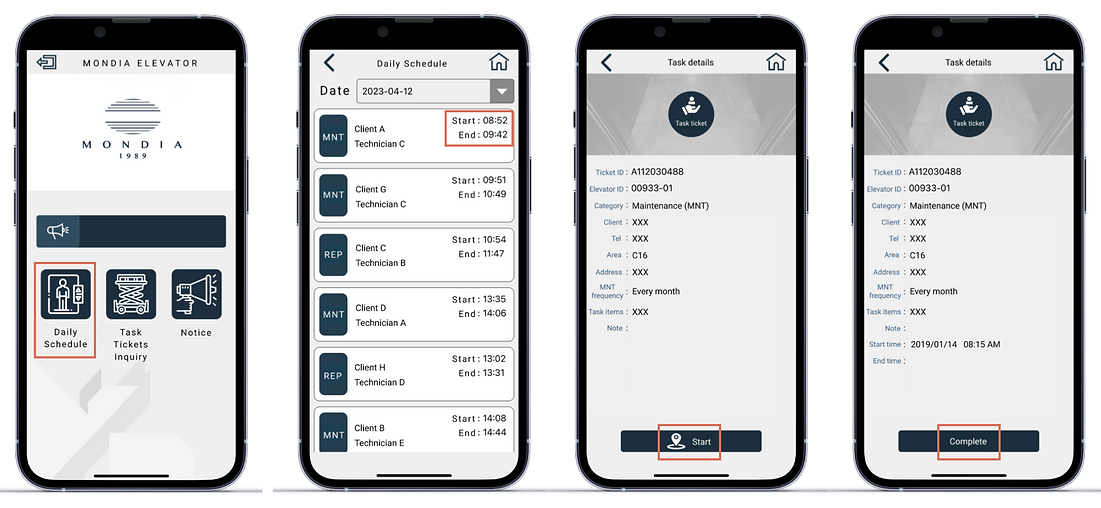MONDIA
WORKFLOW MANAGEMENT
A workflow management platform simplifying work process and saving time on inefficient communication


Project type
Client project
Duration
5 months (Sep 2018 - Feb 2019)
Role
Research
Design
Testing
Tools
Adobe Suite
Figma
WORKFLOW MANAGEMENT PLATFORM

App
Allows technicians to report task status and check task details without calling administrative staff

Backend System
Allows administrative staff to schedule and assign tasks quickly and faultlessly
OVERVIEW
Background
MONDIA is an elevator company providing services of installing, maintaining and repairing elevator systems. Their daily workflow involved lots of manual effort. Administrative staff had to schedule and assign tasks to technicians
Problem
01 Administrative staff spent a lot of time on scheduling and assigning
tasks to technicians
02 Administrative staff assigned the same task to different technicians
due to miscommunication
03 Technicians needed to call administrative staff while finishing
assigned tasks or having questions about previous task details

Administrative staff was writing task tickets

Technician was calling staff to inquire about task details
Goal
01 Help administrative staff reduce time spent on task assignment
02 Help administrative staff reduce assignment errors
03 Help technicians finish daily tasks on schedule
RESEARCH
After understanding the client’s goal, I started to conduct research to delve into administrative staff and technicians' daily workflow.
Fly On The Wall Observation
One-week observation in MONDIA’s office and two-day field research with a technician in order to observe administrative staff and technicians’ daily work routine

Observing administrative staff’s daily routine in MONDIA’s office
User Interview
• Focus group: let administrative staff and
technicians to discuss their workflows and
share their opinions
• Semi-structured interview: asked follow-up
questions and delved into their thoughts and
experiences

Employees were sharing their opinions about workflows
Key Insights
01 Administrative staff wanted to make assignment process less tedious
and align with other staff so as to reduce the errors
02 Technicians hoped to report task status and check previous task
details easily and quickly
03 Both of them thought that they spent much time communicating and
wanted to communicate in a timely manner
DEFINE
Based on the findings that I gathered from research, I created two personas for two types of employees in order to guide the design decisions through the process.
User Personas


DESIGN
Firstly, we identified administrative staff and technicians' existing work process, which involved lots of manual efforts and was time-consuming.
⇠ Before: Existing workflow


Administrative staff


Technician
→ After: Workflow management platform
In order to simplify existing workflow and address administrative staff and technicians' problems accordingly, we decided to digitize the workflow. First, we created the information architecture of workflow management platform. The platform was divided into two parts. App is technician-facing and backend system is staff-facing.



Administrative staff
Technician
App is more accessible to technicians as they are always on-the go
Backend system is more suitable for administrative staff to input data and process task assignment
Once we built out the structure, we started to design the detailed functions that could address administrative staff and technicians' problems.
Problem 01
Administrative staff spent lots of time on finding clients in close distance and arranging tasks accordingly
⇠ Before: Paper-based processes
Administrative staff had to go through clients' details and listed those in close proximity as one area

They also needed to manually fill out task details for each task

→ After: Digital workflow
On backend system dashboard, we designed 4 tabs. In "System Flowchart", administrative staff created a profile for each client and input their details and assigned area. When administrative staff needed to tasks for certain area, they could go to "Work Plan Ticket" and choose certain area. Clients in the same area would appear in the form. Then administrative staff could choose the client they wanted to assign a task for, the system would autofill this client's details.
Administrative staff could assign an area for each client in their profile

The system would autofill the highlighted fields, which save administrative staff the time of filling out task details

Problem 02
Assignment errors happened due to miscommunication
⇠ Before: Reassigned the same task if administrative staff didn't communicate clearly


Administrative staff
→ After: Synchronous task assignment status
After administrative staff created a task in "Work Plan Ticket", the system would generate a task ticket number. Administrative staff had to go to "Task Assignment", input this ticket number and assign the task to a technician. Once the task was assigned, it would appear in the form. In this way, every administrative staff would know what tasks were assigned and further prevent them from reassigning the same task.
The form, highlighted in orange box, would display task assignment status so as to prevent the situation of reassignment

Problem 03
Inefficient communication between administrative staff and technicians
⇠ Before: Technicians spent much time making unnecessary calls

Administrative staff



Technician
→ After: Directly report task status and check previous task details in App
In order to help technicians report task status and check previous task details without keeping calling administrative staff, we created two in-app features, report task status and check previous tasks.
Technicians can tap "Daily Schedule", then locate their assigned tasks and start the task. When finishing the task, they can just tap "Complete" to report the status

Technicians can tap "Task Tickets Inquiry", then use "Search Condition" to find the task they're looking for and check the details

OUTCOME
After launching this workflow management platform, administrative staff's assignment error rates decreased from 5% to 0%. As the time spent on assignment process declined, their labor cost reduced by 34%. Regarding technicians' performance, their task completion rate increased from 75% to 88%. Overall, it helped both of them spend less time on repetitive tasks and inefficient communication and meanwhile increase productivity at work.

Administrative staff was assigning tasks on backend system and technician was checking task ticket on app
